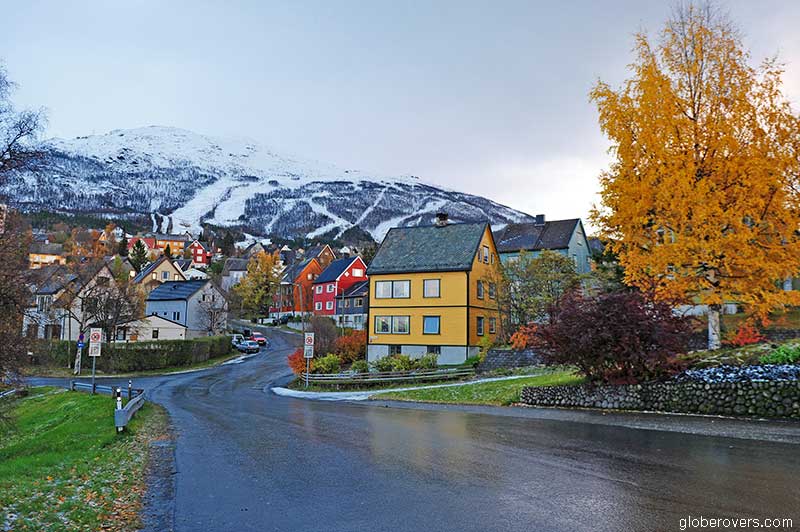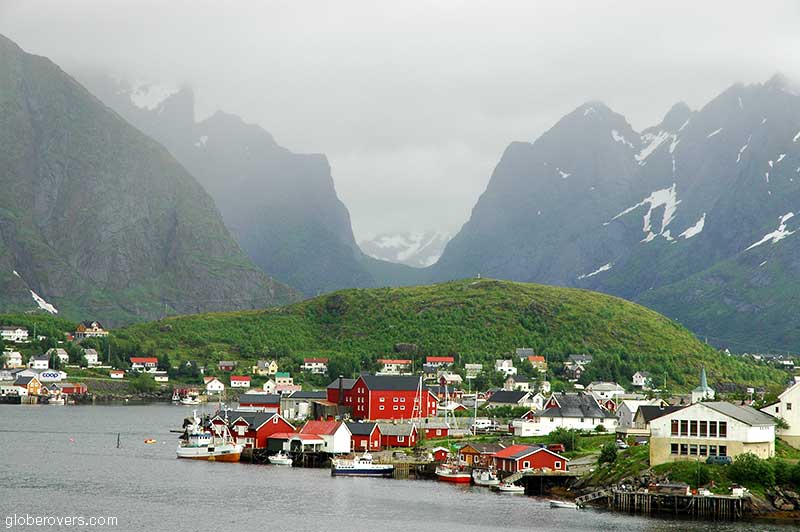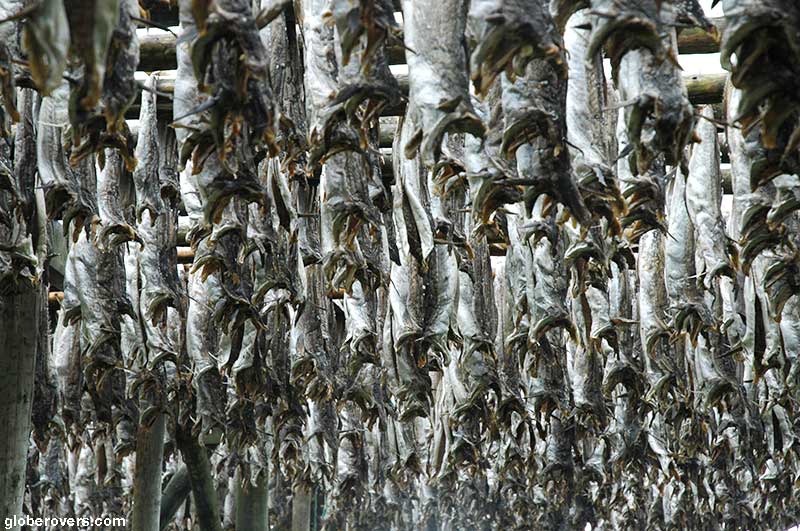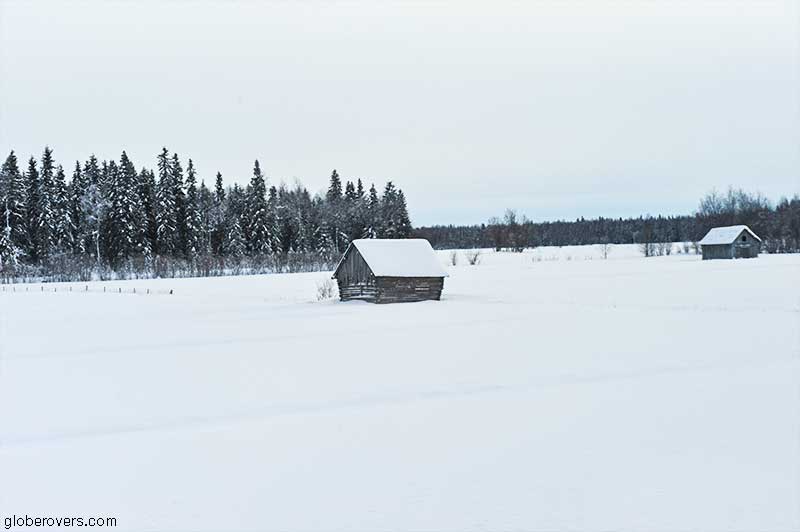
Lapland or Sápmi, is an ethno-cultural region which stretches over northern Fenno-Scandinavia (northern regions of Sweden, Finland, Norway, and Russia). It is also known as “the land of the midnight sun, and the Aurora Borealis”.
Who does not dream about visiting Lapland to see the northern lights (Aurora Borealis) while dog sledding…
Why travel to Lapland?
- The low-down: Who does not want to take visit Lapland to be on top of the world – or almost on the top. Who does not want to see the “northern lights” and enjoying a day on the snow with the dogs! Come to Lapland and make your dreams come true.
- The brightest highlight: The snow in winter, the green grass in summer. The emptiness, the excitement. Lapland is a whole different world!
- Intrepid destination: Absolutely, its a very large area and tourists are scarce.
- GlobeRovers score (10 is highest): This is one of my favourite places on earth, at any season. If I have to choose one season, it will be during the coldest part of the year (Jan / Feb) when Lapland turns into a winter wonderland. I’ll score it 8.8/10.

Table of Contents
Thinking about Lapland…
Thinking about Lapland, the word itself may cast some images of colourful Laplanders, known as the Sámi peoples, roaming reindeer, the home of Santa Claus, the Aurora Borealis (Northern Lights), and the midnight sun. But, there is a lot more to Lapland than you ever imagined.
“Land of the midnight sun, and the Aurora Borealis”
Also known as Sápmi, Lapland includes the Nordic regions of Sweden, Finland, Norway, and Russia. It has traditionally been inhabited by the Sámi people, known in English as “Lapps” or “Laplanders”.
In the north, Lapland is bounded by the Barents Sea, to the west by the Norwegian Sea and on the east by the White Sea. The latter is a southern inlet of the Barents Sea located on the far northwestern coast of Russia.

Svalbard, the Norwegian archipelago in the Arctic Ocean, located midway between continental Norway and the North Pole, is technically not part of Lapland, but it makes perfect sense to include Svalbard within the same travel itinerary. Once you are this far north in the world, you might just as well hop on a plane in Tromsø, in northern Norway, for the ninety-minute flight up to Longyearbyen, the largest settlement and administrative centre of the Svalbard Islands.
Sadly, Lapland is not what it used to be. Nowadays, the traditional Sámi people constitute only a small minority of about 5% of the total Lapland population. Russians and Norwegians are the most dominant ethnic group.

Image by WikiImages from Pixabay
Even though the Sámi people are in the minority, there are generally no political calls advocating secession. However, several groups desire an increase in territorial autonomy and even self-rule. The visionary “Kingdom of Lapland” has its own flag, and describes itself as a “gargantuan, pleasant nation” with “hard-nosed, hard-working Lapps” with a strong economy driven by the “trout farming industry, with major contributions from pizza delivery, and soda sales”.
The Kingdom’s national animal is, unmistakably, the woolly polar bear. We can only imagine what the national bird would be! Unmistakably: the mosquito. Let this be a tip to bring along industrial-strength insect repellent if you visit during late spring and early summer.

Let’s head up north, far north, to the incredible Kingdom of Lapland! Norway, Sweden, Finland, and a bit of the Svalbard Islands.
Norwegian Lapland
Norwegian Lapland is better known as Finnmark, yet formerly known as Danish Lapland. All very confusing but it can be explained!
Located in the extreme northeastern part of Norway, Finnmark borders Troms county to the southwest, Finnish Lapland to the south, and the Russian Murmansk Oblast Lapland to the east. In the northeast lies the Norwegian Sea (Atlantic Ocean), and the Barents Sea (Arctic Ocean) lies to the north and northeast.
Norwegian Lapland is known for its deep blue fjords, red-roofed villages, succulent seafood, and stunning winter wonderland!
Norwegian Lapland, however, generally also includes Troms county and the northern parts of Nordland, south of Finnmark, which makes this the most populated and largest region within the greater Lapland.
Some of the most notable settlements in Norwegian Lapland are the towns of Bodø, Narvik, Harstad, Tromsø, Alta, Hammerfest, Kirkenes, and the most northern European settlement, Nordkapp.
Northeast of Lofoten lies the picturesque town of Narvik, which is best reached on the Arctic Circle Train from the Swedish towns of Kiruna or Luleå. From Narvik, a 3½-hour scenic trip by bus goes all the way to the beautiful town of Tromsø. In winter take the gondola to Storsteinen (421 m above sea level) for stunning views over the winter wonderland below you!
Narvik, an all-year-round travel destination, is popular for its beautiful mountain setting, coloured houses, alpine skiing at nearby Narvikfjellet, and as a springboard for adventures among the fjords.




While the Norwegian language dominates across the region, the Sámi speakers are mainly found inland and in Nordland county, Troms county, and mostly in the far northern Finnmark county which borders Finland.
The region is also home to the Kvens people (Norwegian Finns) and the Russians who mostly live in Kirkenes along the Russian border.
Why known as Danish Lapland? Because during the 16th century Norway was part of the multi-national state of Danmark–Norge.
Geographically, Finnmark is larger than the entire country of Denmark. Add to that the rest of Norwegian Lapland, and we are talking about a very large area.

What is a traveller to do with limited time and money when the area is so large, public transportation is limited, and the cost of travelling is among the highest in the world? You focus on a few places and spend your money and time wisely!
One of the most beautiful parts of Norwegian Lapland is the Lofoten Islands in northern Nordland. Popularly described as “Norway’s untamed islands”, Lofoten is famous for its spectacular natural attractions such as the mountains, fjords, Northern Lights in winter, the midnight sun in summer, and many quaint off the beaten track red-roofed villages.
Reine is a fishing village in the southern part of the Lofoten Islands. Located in an idyllic mountain setting far north of the arctic circle, an even more picturesque village named Å lies about 10 km southwest of Reine.

Located far above the Arctic Circle, the turbulent waters of the Norwegian Sea bring in a constant flow of nutrition to the marine life, which in turn feeds the birds. Fishing is popular, particularly cod, which is legendary in the making of “stockfish”. Walk around the villages and notice the unsalted cod drying in the cold air on wooden racks. Cold-adapted bacteria matures the fish in a similar way to cheese making, and the fish is then used in many local dishes, or exported to Europe.


The islands are also home to large colonies of puffins and many other birds.


Swedish Lapland
Swedish Lapland, written by the Swedes as “Lappland” and known as Sápmi by the local Sámi people, comprises about a quarter of Sweden’s total land surface area. The Swedish Lapland used to extend much further east, until in 1809 when the Russian Empire, under Emperor Alexander I (a.k.a. Alexander the Blessed), annexed the eastern part of the Swedish dominion and created the Grand Duchy of Finland (today’s modern Finland). It was ruled by Russia until 1917 when, after the February Revolution and the October Revolution, Finland declared its independence.
Swedish Lapland’s rugged wilderness has endless forests of pine and spruce, thundering rivers, snow-covered landscapes, and peaceful lakeside villages amongst the hills
The irresistible allure of the Swedish Lapland is its vast and sparsely populated wilderness with seemingly endless pine and spruce forests. Travellers, both Swedish and foreign, come here to experience remoteness at its best.
Whether you come here during the short summers, the cool spring and autumn, or the long cold winter months, there is always something thrilling to experience.
The University town of Luleå is located along the shores of the Bay of Bothnia. Surrounded by bays and islands, the seawater around the town freezes in winter which creates ample opportunities for winter sports such a skating, cross-country skiing, ice hockey, ice fishing, snowmobiling, snowkiting, fat-wheel biking, dog-sledding, or just hiking on the ice.


☛ Read more: Dogsledding on the Svalbard Islands

Other than the vast wilderness and the natural beauty of lakes, rivers, and snow-covered landscapes, the culture of the local Sámi people is colourful and intriguing. Look out for the fascinating Duodji, the Sámi handicraft, which originates from a time when these people were true nomads and men in their daily lives wore antler-headdresses and were adorned with Sámi knives and items made from wood and bone. Attend a Sámi festival and you may hear their “yoiks” which is a chant traditionally sung a cappella.
The Jokkmokk’s Marknad Festival, held during February in the village of Jokkmokk, northwest of Luleå, is the largest indigenous Sámi festival in the world.
George R.R. Martin in “A Game of Thrones” once proclaimed that ‘nothing burns like the cold.’ While the cold in Swedish Lapland can burn very intensely, it’s a thrilling bite that you will never forget!
In winter, take the train from Luleå to the town of Kiruna from where a short taxi ride goes to the village of Jukkasjärvi. The village is popular from December until April when its annual ice hotel (branded as ICEHOTEL), a hotel made entirely from ice, rises next to the Torne River.
The ice hotel borrows hundreds of tonnes of crystal-clear ice from the frozen river which is then carved and sculpted into the most beautiful ice bedrooms, complete with ice-made chandeliers and furniture. Enjoy a vodka in an ice-carved tumbler in the ice-carved bar.

From Kiruna, continue on the Arctic Circle Train past beautiful winter landscapes all the way to Narvik in the Norwegian Lapland.
In summers, enjoy the midnight sun from May to mid-July, and in winter see the Northern Lights colour-painting the dark skies. Swedish Lapland is truly beautiful!



Finnish Lapland
Finnish Lapland, “Lappi” in the Finnish language, is the largest and northernmost region of Finland. Historically it was part of the Swedish Lapland until 1809 when the Russian Empire annexed the eastern part of the Swedish dominion and created the Grand Duchy of Finland which is known merely as Finland today.
Finnish Lapland is home to national parks and gorgeous lakes filled with fish. Spot the reindeer, wolves, wolverines and brown bears while hiking and then relax in a traditional Finnish sauna
Finnish Lapland is dominated by no less than eight national parks. Nature lovers can enjoy the scenery by land or by water at any time of the year. Much of the area has free public access where hikers can roam the great outdoors.
The Pallas-Yllästunturi National Park in the far northwest along the Swedish border has 350 km of marked summer trails and over 500 km of skiing trails. Overnight stays are in historic Lappish villages where in winter you can see the Northern Lights.

The Urho Kekkonen National Park in the northwest along the Russian border has 200 km of marked summer trails and extensive ski trail networks. The remote fell (Old Norse word for mountain) of Korvatunturi is famous among Finns as the home of Santa Claus (Joulupukki in Finnish) where, according to local folklore, he has his secret toys and trinkets workshop.
A little further south lies the Pyhä-Luosto National Park where deep gorges slice through rugged hills. Summer trails cover about 75 km and there are 120 km of skiing trails.
I found myself utterly numbed by the intense cold in Lapland, but reminded myself that there is nothing as invigorating as scraping off ice crystals from my eyelashes
Australian Traveller
Lapland is particularly renowned for its husky, reindeer, and snowmobile safaris. There is nothing more beautiful than taking a long reindeer safari or dogsled journey over tens of kilometres accompanied by a traditional lunch and hot beverages.

About 120 km north of the town of Kemi at the top of the Bay of Bothnia, lies the town of Rovaniemi. Travel here by car, or even by train. The Santa Claus Village is about 8 km north of this town and certainly worth a visit – even if just to say that you have been to the official home of Santa Claus in Finnish Lapland! Here you will find the Santa Claus Post Office to mail a special postcard back home, and of course the official Santa Claus Office where you can meet the man himself.
The Arctic Circle goes right through the village, so step back and forth over the white painted line. Nearby is Santa Park, an underground amusement park, complete with elf shows, sleigh rides and a Christmas carousel.

Try to visit the Lainio Snow Village, 200 m above the Arctic Circle, or settle for the more accessible castle made of snow (written as SnowCastle) in Kemi. A real artwork made of ice and snow, the SnowCastle offers the SnowRestaurant, SnowChapel and SnowHotel.
The restaurant at the SnowCastle of Kemi offers a truly unique experience of dining in a restaurant made completely out of snow. Menu items at the restaurant include local fish like salmon and perch served with vegetables. You will also find an array of soups such as the “cheesy reindeer soup with baguette” and main dishes such as “sliced reindeer, potatoes and root vegetables with game sauce and lingonberries”. The “cranberry mousse cake” as dessert is always popular. Don’t forget the warm mulled wine and homemade berry juice.
A three-course dinner with soup, main, and a dessert (excluding drinks), costs €58 per person but includes the €15 entrance fee for the SnowCastle. Restaurant reservations must be made at least two working days in advance.


In winter you can enjoy the endless temptations of hot saunas, the Northern Lights, and reindeer rides on traditional farms. Welcome to Finnish Lapland!
I have not yet been to Russian Lapland, but hope to soon travel around Russian Siberia in the winter.
Start making plans to visit Lapland. It will be an unforgettable trip!
☛ Read more: 10 cool excitements in Lapland


Further reading
- A Winter Wonderland Trip To Rovaniemi, Finnish Lapland
- How to Plan a Successful Trip to Finnish Lapland
- 11 Things to do in Lapland Winter
- 13 Reasons to Visit Finnish Lapland
- A Travel Guide to Finnish Lapland: When, Where & How to Go

Blog post and photos by Peter who has been travelling almost full-time since 2005 and has been to over 122 countries. He visited several countries, such as Japan, more than 20 times. Peter is Editor-in-Chief and Publisher of GlobeRovers Magazine, an independent travel magazine focused on intrepid destinations.
